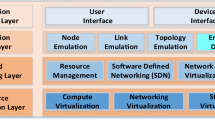Abstract
In the recent years, resource virtualization technologies of different types have been widely used in the ICT industry, particularly in cloud computing domain. These virtualization technologies can squeeze out hardware potential and consequently can significantly save CAPEX and OPEX. Virtualization technologies are adopted in network emulation to emulate heterogeneous nodes of target networks. At present, network emulators typically utilize legacy x86-based virtual machines (VMs) and light-weighted containers to emulate network nodes of heterogeneous architectures including ARM, SPARC, PPC, etc., which introduces software incompatibility to the original system software, protocols and applications, and may consequently jeopardize emulation fidelity. This paper focuses on mitigating the emulation incompatibility problem caused by node heterogeneity. Firstly, this problem is thoroughly investigated and analyzed on a cloud-based network emulation platform. Then, a hybrid virtualization approach concurrently utilizing multiple virtualization technologies, namely KVM, QEMU, and Docker to emulate heterogeneously architected nodes is derived and then implemented in the cloud-based network emulation platform. Functional verification and performance evaluation experiments have been carried out and have led to the conclusion that the elaborated hybrid virtualization approach can effectively dispose of the emulation incompatibility problem with affordable performance degradations. In addition, a case study of applying the hybrid virtualization approach to emulate a space-ground integrated network (SGIN) is conducted to show its effectivity and efficiency.









Similar content being viewed by others
References
Wellington RJ, Kubischta MD (2003) Wireless network emulation for distributed processing systems. In: IEEE Military communications conference, 2003. MILCOM 2003, Boston, pp 475–480
Yousefi’zadeh H, Li X, Furmanski W, Lofquist DB (2007) Emulation of fading wireless link effects in NEWS wired testbed. In: MILCOM 2007 - IEEE military communications conference, Orlando, pp 1–7
Bonney J, Bowering G, Marotz R, Swanson K (2008) Hardware-in-the-loop emulation of mobile wireless communication environments. In: 2008 IEEE aerospace conference, Big Sky, pp 1–9
Beuran R, Nguyen LT, Latt KT, Nakata J, Shinoda Y (2007) QOMET: a versatile WLAN emulator. In: 21st International conference on advanced information networking and applications (AINA ’07), Niagara Falls, pp 348–353
Beuran R, Nakata J, Okada T, Nguyen LT, Tan Y, Shinoda Y (2008) A multi-purpose wireless network emulator: QOMET. In: 22nd International conference on advanced information networking and applications - workshops (aina workshops 2008), Okinawa, pp 223–228
Beuran R, Tariq MI, Miwa S, Shinoda Y (2015) Wireless network performance evaluation through emulation: WiMAX case study. In: 2015 International conference on information networking (ICOIN), Cambodia, pp 265–270
Ahrenholz J, Danilov C, Henderson TR, Kim JH (2008) CORE: a real-time network emulator. In: MILCOM 2008 - 2008 IEEE military communications conference, San Diego, pp 1–7
Nickelsen A, Jensen MN, Matthiesen EV, Schwefel H (2008) Scalable emulation of dynamic multi-hop topologies. In: 2008 The fourth international conference on wireless and mobile communications, Athens, pp 268–273
Soles LR, Reichherzer T, Snider DH (2015) Creating a cost-effective air-to-ground network simulation environment. In: SoutheastCon 2015, Fort Lauderdale, pp 1–5
Ramneek W, Choi W (2015) Seok: wireless network mobility emulation over wired testbeds: a review. In: 2015 17th international conference on advanced communication technology (ICACT), pp 431–435
Giovanardi A, Mazzini G (2006) Emulation architecture implementation and design. In: 2006 3rd Annual IEEE communications society on sensor and ad hoc communications and networks, pp 723–728
Giovanardi A, Mazzini G (2005) Ad hoc routing protocols: emulation vs simulation. In: 2005 2nd international symposium on wireless communication systems, pp 140–144
Giovanardi G, Mazzini G, Veronesi R (2005) Network emulation in the SAM simulator. In: 2005 IEEE 16th international symposium on personal, indoor and mobile radio communications, pp 1302–1306
Maier S, Grau A, Weinschrott H, Rothermel K (2007) Scalable network emulation: a comparison of virtual routing and virtual machines. In: 2007 12th IEEE symposium on computers and communications. Las Vegas, USA, pp 395–402
Mehta D, Jaeger J, Faden A, Hebert K, Yazdani N, Yao H (2009) A scalable architecture for emulating dynamic resource allocation in wireless networks. In: MILCOM 2009 - 2009 IEEE military communications conference, Boston, pp 1–7
Balasubramanian D, Dubey A, Otte WR, Emfinger W, Ku- mar PS, Karsai G (2014) A rapid testing framework for a mobile cloud. In: 2014 25nd IEEE international symposium on rapid system prototyping, New Delhi, pp 128–134
To MA, Cano M (2015) DOCKEMU – a network emulation tool. In: 2015 IEEE 29th international conference on advanced information networking and applications workshops, pp 593–598
Lu T, et al. (2016) A scalable network emulation architecture for space internetworking. In: 2016 IEEE International conference on communication systems (ICCS), Shenzhen, pp 1–5
Deng B, Wang X, Jiang M, Liu Y (2017) An emulation architecture for the integration of virtual and physical networks. In: 2017 8th IEEE international conference on software engineering and service science (ICSESS), Beijing, pp 399–405
Ly-Trong N., Dang-Le-Bao C., Le-Trung Q. (2018) Towards a large-scale IoT emulation testbed based on container technology. In: 2018 IEEE Seventh international conference on communications and electronics (ICCE), Hue, pp 63–68
Acknowledgements
This work is partially supported by the National Natural Science Foundation of China (Grant No. 61402085, 61872051, and 61571104) and the Science and Technology on Communication Networks Laboratory (Grant No. XX17641X011-03), the 54th Research Institute of China Electronics Technology Group Corporation, Sichuan Science and Technology Program (No. 2018JY0539), Key projects of the Sichuan Provincial Education Department (No. 18ZA0219), Fundamental Research Funds for the Central Universities (No. ZYGX2017KYQD170), and Innovation Funding (No. 2018510007000134). Dr. Dingde Jiang is corresponding author of this paper (email: jiangdd_99@sina.com)
Author information
Authors and Affiliations
Corresponding author
Additional information
Publisher’s Note
Springer Nature remains neutral with regard to jurisdictional claims in published maps and institutional affiliations.
Rights and permissions
About this article
Cite this article
Lai, J., Tian, J., Liu, R. et al. A Hybrid Virtualization Approach to Emulate Network Nodes of Heterogeneous Architectures. Mobile Netw Appl 26, 781–793 (2021). https://doi.org/10.1007/s11036-019-01427-z
Published:
Issue Date:
DOI: https://doi.org/10.1007/s11036-019-01427-z




